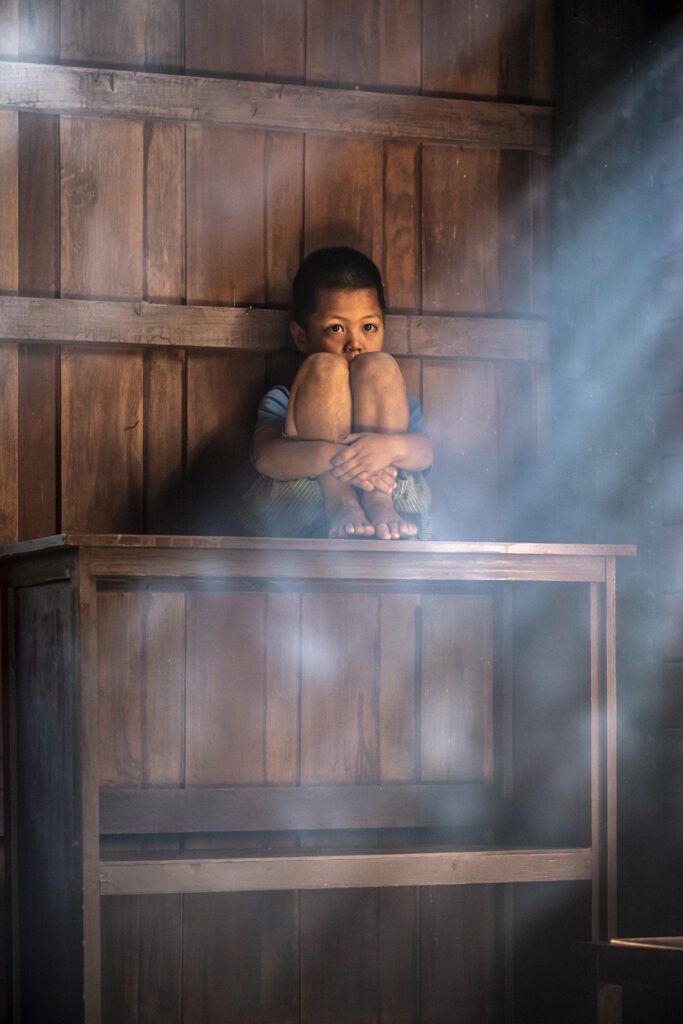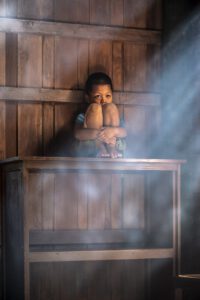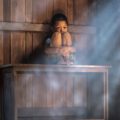Childhood trauma forms: when children learn that they are not wanted
- Childhood trauma forms: when children learn that they are not wanted
- Childhood trauma forms: hidden (and less hidden) rejections
- Childhood trauma forms: replacement children
- Childhood trauma forms: unresponsive parents
- Childhood trauma forms: how unwanted children react
- Childhood trauma forms: toxic guilt
- Childhood trauma forms: therapy approaches
Children are completely dependent on the people around them. If a child must learn that it is not wanted by parents or primary caretakers, it cannot interpret that situation as abusive. In a child’s world, people cannot be bad and evil at the same time. And as for a child, parents cannot be evil, it follows for the child that itself must be bad the way it is and that it is its fault that parents cannot love the child. This toxic form of rejection is a form of emotional abuse. If there is not at least one parental figure conveying unconditional love to the child, it cannot escape the abuse in such an environment.
Rejecting messages are sometimes verbal and directly addressed to the child. Children are told at an early age that they should leave home as soon as they have finished school to learn to stand on their “own two feet”. Then the expulsion takes place under this pretext and the parents pretend that they only want what is best for the child, when in reality they just want to get rid of the child. Some parents also tell their child directly. “Actually, we didn’t want another child”, “You were a little accident”, “If you hadn’t come, I could have finished my studies, and we could afford a lot more today, but well, now you’re here”, etc. Even if an attempt is made to soften the effect somewhat by smiling ironically, the underlying message cannot be ignored by a child. In particularly irritated moments and with parents who are completely overwhelmed or have a high potential for aggression, the (usually somewhat older) child is often even openly threatened. “I’ll chase you out of the house again”, “Make sure you leave; otherwise I can’t guarantee anything” or “Get out of my sight, I can’t see you any more”.
More often instead, rejections are non-verbal or indirectly expressed, through derogatory looks and dismissive and devaluing behaviour towards the child. This is also the case, when a child witnesses his parents talking about him in front of others in a way that makes it clear that he would be better off not being there. Often the message is also conveyed in the form of a “myth of a difficult birth”, which is then brought up again and again at every suitable and unsuitable opportunity. “I almost died giving birth”, “You hurt mummy a lot back then”, etc. The subliminally transmitted message is always “If you hadn’t come, I (we) would be better off”. Beyond this, the spectrum of non-verbal rejection ranges from (attempted) abortions and infanticide to the abandonment of the child to a children’s home or the release of the child for adoption and the subsequent “chasing out of the house”.
Childhood trauma forms: replacement children
Equally toxic are messages comparing a child unfavourably to another sibling, demised before growing up. Parents can tragically lose a child and have another child later, after they have mourned and overcome the loss of their previous child. A replacement child instead is born after the loss of a child and before the parents have accepted their previous child’s death, and, hence, are still being stuck in the process of grieving. Such a replacement child is manipulated to fill a void that the parents were unable to heal from. While these parents, having lost their child, are still experiencing a lot of emotional pain, their trouble coping with that loss results in likewise painful problems for that child. Next to various developmental disturbances, replacement children will have trouble carving an identity for themselves because they are made to feel like they were living in the shadow of someone else.
Some such children do not even know that they are a replacement child, when the parent’s bereavement is concealed from them. Often these children will struggle with self-worth and identity issues, without being able to find the reason behind their struggle. To be able to work through their issues and reframe the situation, they need to learn about the causing situation.
In 1979, clinicians Robert Krell and Leslie Rabkin, identified three patterns that emerge in grieving parents’ interactions with „replacement” children: The „haunted” child who lives in a family drowning in silence and repressed guilt; the „bound” child who is idolized but also overprotected and confined at every turn to protect him or her from every conceivable danger; and the “resurrected” child who is treated like a reincarnation of the dead sibling, sometimes even given the sibling’s name and forced to dress like her or him. (Vincent van Gogh and Salvador Dalí both had brothers with the same name who died before they were born and are examples of “resurrected children.”) These patterns are like unconscious scripts for how family members interact with each other, which can become so rigid that there is no escape.
Childhood trauma forms: unresponsive parents
Emotional neglect, therefore, typically underlies most evident childhood traumatizations. Parents who routinely ignore or turn their backs on a child’s calls for attention, connection or help, abandon their child to unmanageable amounts of fear, and the child eventually gives up and succumbs to depressed, death-like feelings of helplessness and hopelessness – abandonment depression or the “black night of the soul”.
Therefore, even without overt or covert rejection, a total lack of reactiveness of a parental figure to a child’s needs, joys and predicaments, produces even more vicious consequences. Then the poor child feels unseen, regardless of what it does or want. The child comes to learn that their life simply is not relevant for their parents. Yet, instead of feeling angry with that poor parenting, they will internalize guilt and shame for being so worthless and inadequate that their existence is a burden for their environment. Not only do these types of rejection magnify the child’s fear, but they eventually add a coating of shame to it. Over time this fear and shame begets the aforementioned toxic inner critic that holds the child, and later the adult, totally responsible for his parents’ abandonment, becoming the trauma survivor’s own worst enemy, who grows into complete identification with his inner critique.
In an effort to still somehow gain attention then, self-criticism runs non-stop in a desperate attempt to gain one morsel of positive recognition by avoiding even the slightest mistakes. Drasticizing becomes obsessive to help the child foresee and avoid worsening neglect. At the same time, it continuously fills her psyche with stories and images of catastrophe. The survivor becomes imprisoned by the fear of the impending doom around every corner.
Childhood trauma forms: how unwanted children react
If a child internalizes the rejection, it will always be prone to fight against feelings of inadequacy later in life. As deep down, it permanently questions its very being.
In case of a flight reaction, it will become ensnared in a perfectionist strive for more performance and a “zero-fault tolerance”. As good performance and “nice” behaviour are simply be taken for granted, while less than that, or any kind of “naughtiness” will be criticized or even punished, the individual will later feel “OK” only if she or he always(!) does everything perfectly. Such a person then overfulfils every demand, if not in all areas of life, then at least in selected ones. For example, at work, which is very common. A person never feels being or having done good enough.
With a fawning reaction, it may try to become Everybody’s Darling, and will always put others above itself. Later, when they have grown up, they are completely dependent on the attention and goodwill of others for their self-worth. Such a person is happy to forego the fulfilment of his or her own needs, until they habitually fail to even register them. Most important is not to fall out of favour with others. This often goes to the point where a person can no longer perceive his own needs.
A fighting response harnesses narcissistic ego defences to keep the self-image stable. People with a narcissistic fight reaction try to counter their own perceived inferiority by overcompensating. Some such people prove their own worth again and again (because they secretly can’t believe it themselves). Another possible reaction of this category is rebellion. It comes from a defiant part of the child’s ego. If the child has learned early on that he can literally pull a leg and still not get any recognition, he may learn that the parents or parental figures will turn towards him if he really makes a ruckus. Of course, the parents will then react very negatively, but at least they are thus forced to turn their attention to their child. Those who had to experience in their childhood that attention can only come in negative form, if at all, sometimes have a desperate career as troublemakers ahead of them later on. For these children, even painful punishment or other negative attention is much better than no attention at all. Utter abandonment and total rejection is unbearable, for helpless children and grown-ups alike.
Sometimes narcissistic reactions can lead to a never-ending series of romantic “conquests”, abandoned as soon, as the conquest has been successful. There is little romanticism involved in these relationships, as they are simply instrumentalized to stabilize the fragile self-value of a narcissist. At the same time, with frequently changing partners, narcissistic “fighters” can avoid exposing themselves to the danger and vulnerability of too deep a bond and the closeness that comes with it. So in their view, they have killed two birds with one stone. At least on the surface because underneath, of course, both parties involved pay the price. If the relationship is pursued beyond the conquest, it is bound to turn into a reconstellation of active toxic abuse of the partner eventually.
In harder cases, not only relationships suffer from poorly managed outbursts of negative emotions, but a person may repeatedly come into conflict with the law. Such an individual becomes known for outbursts of rage or difficulties in observing applicable rules, while often later attracting a partner who has a similar or complementary theme. That partner will either behave in a hot-tempered manner too, or do the opposite and duck away when others become hot-tempered. Therefore, sometimes both partners deal with it in the same way. Yet, it is much more common that “opposites attract”.
A dissociative freeze reaction leads to a child becoming seemingly “lost” in a soothing world of daydreams, appearing eternally unable to get their things together and to get a grip on their lives. The “lost child” retreats from overwhelming family dysfunction. They can spend a lot of time alone, pursue singular interests, and/or struggle to establish or maintain relationships with others. Sometimes, later in life, they develop a compulsive coping mechanism; for example, they may struggle to maintain meaningful employment because they keep playing hours of video games or watch sitcoms for hours on end, a compulsion initially being the only way to cope with family dysfunction. During all that, a lost child may appear as if not caring at all about their dysfunctional family, while they do, and terribly so. They simply cannot tolerate the emotional turmoil that comes with interminable conflicts in their family. They avoid conflict at all costs, as they tend to shut down or check out when things feel difficult. Some “freezing” lost children might feel that they are a burden to their family, so they stay away to avoid the demons or causing the family additional stress.
Corresponding to the Four F’s type, “accepting praise” will follow a different pattern: Someone with an insufficiently stable self-image will have difficulty accepting praise and recognition. They will play them down, “anyone else could have done that”, or quickly pass them over. Sometimes they turn a blind eye to positive feedback, or secretly think that the person praising them is only trying to manipulate them or that the praise will be replaced soon enough with scorn, when the truth will come to the light of day that there is simply nothing to praise in a person like them. The person then behaves according to the statement: “If they accept someone like me, there must be something wrong with them too.”
Some trauma survivors follow their rejection to the bitter end and seemingly remove themselves from life, either bit by bit or in one fell swoop. The spectrum ranges from work addiction and extreme high-risk behaviours such as “driving like mad” or risky sexual behaviour, to eating disorder or alcohol and substance use, sometimes even suicide. Not infrequently, the latter is preceded by fantasies of redemption, with thoughts about those left behind will weep bitterly and repent at the funeral, finally acknowledging regretfully how valuable the person they have just lost was.
Childhood trauma forms: toxic guilt
In all these situations, children learn to reject themselves. Their soul becomes quick to take responsibility and blame for something for which it cannot, by any stretch of the imagination, be held responsible. For example, when there has been a blow of fate in the family and the child was “naughty” shortly before. After absurd government fearmongering during the covid pandemic suggested to children in oversized posters ‘to wash their hands or else their grandparents could die’ not few children came to believe that there was a connection between their inobediance and the demise of an elderly family member. So, children can feel innocently guilty and believe “If it weren’t for me, the others would be better off”. Likewise, children in a divorce can become firmly convinced that they themselves are the reason why daddy left or mommy doesn’t love us any more. That way, rejection will be internalized and thus becomes part of one’s identity.
No matter in which way a child comes to the conclusion that it would be better not to be there, it has few ways of dealing with that. And these reactions are never deliberately chosen. For the rejection to take its effect in a child’s life, it is necessary that the child accepts it for itself. Luckily, some children can filter from rejection their parent’s state of mind rather than to relate the message to him/herself without restriction. Then they recognize the absurdity of the whole process and rejects it as best it can. However, experience shows that these cases are the exception rather than the rule, and at least a part of rejection and horror related to it almost always sticks.
Childhood trauma forms: therapy approaches
The solution is first to learn about the dynamics at work in cPTSD, then downsize the inner critique, and later learn to be “good enough”, next to becoming a good parent to one’s own hurt inner child. Trauma survivors can learn in therapy to cope with emotional outbursts, not to fear the paralysing “black night of the soul” and make healing and corrective relationship experiences instead of old negative ones in the past
Unfairly, this multi-layered and complex process of personal growth is not, of course, a short one, nor can it adequately described here. There will be more posts on the forms of childhood trauma reactions, their consequences and how to handle them. Just remember, whether you are affected yourself or have someone in your environment who is affected by these dynamics, you (or they) are not “mad”. Challenging as the reactions may appear, they are a trauma survivor’s normal reactions to an abnormal, traumatizing situation.
Sources:
Walker, Pete: Complex PTSD: From Surviving to Thriving: A Guide and Map for Recovering From Childhood Trauma
Krell, R. & Rabkin, L.: The Effects of Sibling Death on the Surviving Child: A Family Perspective https://onlinelibrary.wiley.com/doi/10.1111/j.1545-5300.1979.00471.x






